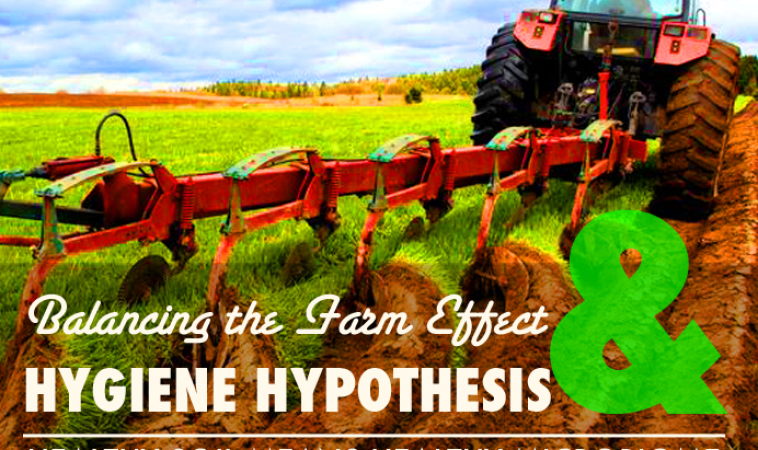Healthy Soil means Healthy Microbiome
Dr. Bianca Garilli, ND
@DoctorBianca
In recent years developing research has continued to amaze us with new information on the connection between our health and the environment. Having been raised on a farm in my teenage years, the emerging link between the diversity and quantity of microbe exposure in the early years of life and subsequent health status caught my immense interest.
In the late 1990’s the term “farm effect” began to gain attention. The hypothesis goes like this: those who are frequently exposed early on, possibly even in-utero, to naturally occurring microbes in healthy soil such as those which might be found on a farm, have lower incidence of a multitude of chronic disease processes including asthma, atopic conditions, allergies, and even some forms of auto-immune disease processes.
A 2003 article in the New York Times by Moises Veaxquez-Manoff reads:
Healthy soil can be viewed as a vibrant community made up of a multitude of various living organisms from bacteria to fungi to worms including the annelids or earthworms and insect larvae such as maggots and grubs. Our health may actually be affected by the soil we are exposed to depending on the content of its organisms!1
Childhood asthma and related allergic conditions have become the most common chronic disorders in the Western world, according to a recent article in Pediatric Allergy and Immunology.2 However, studies have discovered a lower incidence of asthma and atopic conditions in children raised in rural areas and exposed to the “farm effect” versus those raised in an urban environment. This difference is seen even after adjusting for other environmental exposures and lifestyle differences which may occur between these two settings.3 A study published in the American Journal of Respiratory and Critical Care Medicine looked at 1199 children from the rural regions surrounding Quebec, Canada. They categorized them into two groups, those raised on a farm and those not regularly exposed to a farming environment. Results found a lower prevalence of asthma and atopy in those raised on farms in comparison to those not raised on a farm.4
Seasonal allergic rhinitis was first described in the United States and in England in the 1890’s notes a recent review on the topic and by 1900 in England and Germany and in the United States by 1920 the condition was quite common. Interestingly enough, however, hay fever or allergic rhinitis was most well known in affluent populations and rarely diagnosed in the working class population, particularly those living on farms.5
This review goes on to hypothesize the reasons for this higher prevalence of disease among the more affluent, which, according to current health data, is still the case. Although there are many environmental reasons that can be attributed to this relationship, the “Hygiene Hypothesis” has been one of the most frequently studied particularly that additional research has reported potential links between childhood exposure to farm-like microbes and a reduced risk for certain auto-immune disorders such as type I diabetes and multiple sclerosis.6,7
The “Hygiene Hypothesis” explains that humans evolved with a host of infectious agents both within our bodies (our microbiome) as well as externally in our environment where we were exposed to myriad of microbes on a routine basis through air, food and water. With the advent of increased and improved hygiene, exposure to infectious agents was reduced thus leading to fewer infectious disease processes (a good thing in cases such as small pox, tuberculosis, etc) but may also have reduced our exposure to and interactions with the beneficial microbes that were protective against a large spectrum of immune related disorders and against a healthy, robust and appropriate development of immune responses.5
Once again, as we are discovering in so many areas of life, a balance must be found between nature and technology. Daphne Miller, MD, the author of Farmacology: Total Health from the Ground Up, a book which explores the connections between a healthy soil biome and a healthy human body describes the integration of the historical natural ways of farming with the incorporation of technological advances in this manner:
…the idea that a farm is not just a collection of parts but a complex … living system. Implicit in this approach is the idea that true health gains for humans and other members of the farm system are to be had by better understanding the interconnections among these living parts and by using the technologies of modern science to subtly enhance them.8
As we continue to learn more of the interconnectedness between the health of the soil and the health of our bodies the importance becomes clear: a healthy gut microbiome is crucial. With more and more of the population moving towards an urban lifestyle there is a consequential increase in implementation of the hygiene hypothesis and a loss of the “farm effect” and its outcomes. How can those born and raised in an urban environment work to balance the hygienic benefits with the benefits of the farm microbe exposure without purchasing and living on a farm themselves? Thankfully, there are ways to incorporate a little bit of farm-like living, even in the middle of the city. So, regardless if you live on 50 acres or in an apartment, here are a few lifestyle changes which may help create a modified “farm effect” in any body and in any home:
- Grow plants, organically. Cook with and eat them regularly.
- Purchase organic fruits and vegetables from your local farmer’s market.
- Invest in a weekly organic CSA (Community Supported Agriculture) box.
- Eat fermented/cultured food regularly.
- Take a daily probiotic.
 Dr. Garilli is a former US Marine turned Naturopathic Doctor. She runs a private practice in Folsom, California where she specializes in treating and preventing chronic disease states through a personalized lifestyle approach including nutrition, exercise, botanical medicine and homeopathy.
Dr. Garilli is a former US Marine turned Naturopathic Doctor. She runs a private practice in Folsom, California where she specializes in treating and preventing chronic disease states through a personalized lifestyle approach including nutrition, exercise, botanical medicine and homeopathy.
In addition to private practice, she consults with nutritional supplement companies and integrative medical clinics on case studies, professional consultations and educational program development. Dr. Garilli is a member of the faculty at Hawthorn University and a founding board member for the CA Chapter of the Children’s Heart Foundation. Dr. Garilli lives in Northern California with her husband, children and four backyard chickens.
References:
- Velasquez-Manoff, M. A Cure for the Allergy Epidemic? The New York Times. Nov, 9, 2013. Retrieved on June 20, 2015. http://www.nytimes.com/2013/11/10/opinion/sunday/a-cure-for-the-allergy-epidemic.html?_r=1
- Schroder PC, Li J, Wong GW, Schaub B. The rural-urban enigma of allergy: what can we learn from studies around the world? Pediatr Allergy Immunol. 2015 Mar;26(2):95-102.
- Naleway, A. Asthma and Atopy in Rural Children: Is Farming Protective? Clin Med Res. 2004 Feb; 2(1):5-12.
- Ernst P, Cormier Y. Relative Scarcity of Asthma and Atopy among Rural Adolescents Raised on a Farm. American Journal of Respiratory and Critical Care Medicine. Vol. 161, No. 5 (2000), pp. 1563-1566.
- Patts-Mills T, Commins S. Increasing prevalence of asthma and allergic rhinitis and the role of environmental factors. UpToDate. Retrieved on 6/21/2015. http://cursoenarm.net/UPTODATE/contents/mobipreview.htm?39/56/40832
- Heikkinen S, Pitkäniemi J, Kipeläinen M, Koskenvuo J. Does farm environment protect against type 1 diabetes mellitus? Diabetes and Vascular Disease Research.July 2013 vol. 10 no. 4 375-377.
- Okada H, Kuhn C, Feillet H, Bach JF. The ‘hygiene hypothesis’ for autoimmune and allergic diseases: an update. Clin Exp Immunol.2010 Apr; 160(1): 1–9.
- Miller, Daphne. (2013). Farmacology: Total Health from the Ground Up.New York, New York. Harper Collins.

















